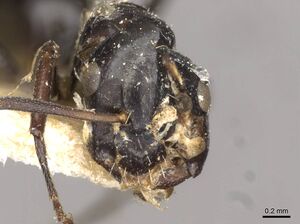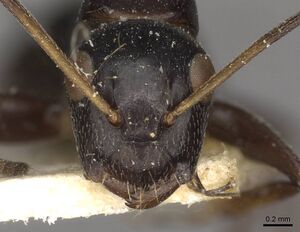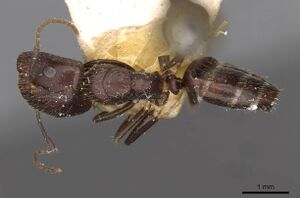Camponotus reticulatus
| Camponotus reticulatus | |
|---|---|

| |
| Scientific classification | |
| Kingdom: | Animalia |
| Phylum: | Arthropoda |
| Class: | Insecta |
| Order: | Hymenoptera |
| Family: | Formicidae |
| Subfamily: | Formicinae |
| Tribe: | Camponotini |
| Genus: | Camponotus |
| Species: | C. reticulatus |
| Binomial name | |
| Camponotus reticulatus Roger, 1863 | |
| Subspecies | |
| |
Identification
Keys including this Species
Distribution
Latitudinal Distribution Pattern
Latitudinal Range: 14.14999962° to -13.167°.
| North Temperate |
North Subtropical |
Tropical | South Subtropical |
South Temperate |
- Source: AntMaps
Distribution based on Regional Taxon Lists
Indo-Australian Region: Borneo, Indonesia, Malaysia, Micronesia (Federated States of), Northern Mariana Islands, Palau, Singapore, Wallis and Futuna Islands.
Malagasy Region: Seychelles.
Oriental Region: Sri Lanka (type locality).
Distribution based on AntMaps
Distribution based on AntWeb specimens
Check data from AntWeb
Countries Occupied
| Number of countries occupied by this species based on AntWiki Regional Taxon Lists. In general, fewer countries occupied indicates a narrower range, while more countries indicates a more widespread species. |

|
Estimated Abundance
| Relative abundance based on number of AntMaps records per species (this species within the purple bar). Fewer records (to the left) indicates a less abundant/encountered species while more records (to the right) indicates more abundant/encountered species. |

|
Biology
Association with Other Organisms
 Explore: Show all Associate data or Search these data. See also a list of all data tables or learn how data is managed.
Explore: Show all Associate data or Search these data. See also a list of all data tables or learn how data is managed.
- This species is a mutualist for the aphid Aphis gossypii (a trophobiont) (Idechiil et al., 2007; Saddiqui et al., 2019).
- This species is a mutualist for the aphid Pentalonia nigronervosa (a trophobiont) (Idechiil et al., 2007; Saddiqui et al., 2019).
Castes
Images from AntWeb
   
| |
| Syntype of Camponotus reticulatus gestiens. Worker (major/soldier). Specimen code casent0910525. Photographer Z. Lieberman, uploaded by California Academy of Sciences. | Owned by MHNG, Geneva, Switzerland. |
   
| |
| Syntype of Camponotus reticulatus gestiens. Worker. Specimen code casent0910526. Photographer Z. Lieberman, uploaded by California Academy of Sciences. | Owned by MHNG, Geneva, Switzerland. |
   
| |
| Syntype of Camponotus reticulatus imparilis. Worker. Specimen code casent0910527. Photographer Z. Lieberman, uploaded by California Academy of Sciences. | Owned by MHNG, Geneva, Switzerland. |
   
| |
| Syntype of Camponotus reticulatus latitans. Worker (major/soldier). Specimen code casent0910528. Photographer Z. Lieberman, uploaded by California Academy of Sciences. | Owned by MHNG, Geneva, Switzerland. |
   
| |
| Syntype of Camponotus reticulatus latitans. Worker. Specimen code casent0910529. Photographer Z. Lieberman, uploaded by California Academy of Sciences. | Owned by MHNG, Geneva, Switzerland. |
   
| |
| Syntype of Camponotus reticulatus sericellus. Worker (major/soldier). Specimen code casent0910532. Photographer Z. Lieberman, uploaded by California Academy of Sciences. | Owned by MHNG, Geneva, Switzerland. |
   
| |
| Syntype of Camponotus reticulatus yerburyi. Worker (major/soldier). Specimen code casent0910533. Photographer Z. Lieberman, uploaded by California Academy of Sciences. | Owned by MHNG, Geneva, Switzerland. |
   
| |
| Syntype of Camponotus reticulatus yerburyi. Worker. Specimen code casent0910534. Photographer Z. Lieberman, uploaded by California Academy of Sciences. | Owned by MHNG, Geneva, Switzerland. |
Nomenclature
The following information is derived from Barry Bolton's Online Catalogue of the Ants of the World.
- reticulatus. Camponotus reticulatus Roger, 1863a: 139 (w.) SRI LANKA.
- Combination in C. (Myrmotemnus): Emery, 1920b: 258;
- combination in C. (Myrmamblys): Forel, 1912i: 90; Santschi, 1921f: 311; Emery, 1925b: 139.
- Junior synonym of indeflexus: Donisthorpe, 1932b: 576.
- Status as species: Roger, 1863b: 3; Mayr, 1863: 459; Smith, F. 1871a: 307; Forel, 1892j: 233; Emery, 1896d: 374 (in list); Bingham, 1903: 372; Wheeler, W.M. 1912a: 47; Emery, 1914b: 181; Wheeler, W.M. 1919e: 111; Emery, 1925b: 139; Karavaiev, 1929c: 239; Karavaiev, 1933a: 320; Wheeler, W.M. 1934a: 179; Chapman & Capco, 1951: 233; Wilson, 1962c: 19; Taylor, 1976a: 88; Taylor & Brown, 1985: 118; Dlussky, 1994: 56; Bolton, 1995b: 120; Karmaly & Narendran, 2006: 104; Clouse, 2007b: 214; Pfeiffer, et al. 2011: 38; McArthur, 2012: 106, 216.
- Current subspecies: nominal plus fullawayi, gestiens, imparilis, jagori, latitans, sericellus, yerburyi.
Unless otherwise noted the text for the remainder of this section is reported from the publication that includes the original description.
Description
Worker. 3.5 mm. long, dark reddish brown, without gloss,antennae, mandibles, part of the border of the head and limbs brownish yellow. Erect hairs are long but not plentiful and absent on tibias. Entire head which is somewhat wider than the thorax, densely covered with thimble like punctations. Clypeus blunt in front, hardly keeled. Frontal area indistinct,funicles of the antennae at the end brownish. Mandibles with 5 teeth, in front black with sparse strong punctations. Thorax arc shaped with dense thimble like punctations, dull. Pronotum is most wide, with rounded sides, with elongated punctations on the sides. Mesonotum narrowing from the front to the rear. Metanotum strongly suppressed, in the rear part abruptly turned down. Node convex at the front and rear with rounded summit. Margins of the gaster yellowish, finely and densely punctate.
Ceylon, one specimen.
References
- Dias, R.K.S., Kosgamage, K.R.K.A. 2013. Occurrence and species diversity of ground-dwelling worker ants (Family: Formicidae) in selected lands in the dry zone of Sri Lanka. Journal of Science of the University of Kelaniya Sri Lanka 7: 55-72 (doi:10.4038/josuk.v7i0.6233).
- Dias, R.K.S., Rajapaksa, R.P.K.C. 2017. Geographic records of subfamilies, genera and species of ants (Hymenoptera: Formicidae) in the four climatic zones of Sri Lanka: A review. Journal of Science of the University of Kelaniya Sri Lanka 11, 23-45. (doi:10.4038/josuk.v11i2.7999).
- Donisthorpe, H. 1932b. On the identity of some ants from Ceylon described by F. Walker. Ann. Mag. Nat. Hist. 10(9): 574-576 (page 576, Junior synonym of indeflexus)
- Emery, C. 1920b. Le genre Camponotus Mayr. Nouvel essai de la subdivision en sous-genres. Rev. Zool. Afr. (Bruss.) 8: 229-260 (page 258, Combination in C. (Myrmotemnus))
- Emery, C. 1925d. Hymenoptera. Fam. Formicidae. Subfam. Formicinae. Genera Insectorum 183: 1-302 (page 139, Combination in C. (Myrmablys))
- Forel, A. 1912j. Formicides néotropiques. Part VI. 5me sous-famille Camponotinae Forel. Mém. Soc. Entomol. Belg. 20: 59-92 (page 90, Combination in C. (Myrmablys))
- Heterick, B.E. 2021. A guide to the ants of Western Australia. Part I: Systematics. Records of the Western Australian Museum, Supplement 86, 1-245 (doi:10.18195/issn.0313-122x.86.2021.001-245).
- Heterick, B.E. 2022. A guide to the ants of Western Australia. Part II: Distribution and biology. Records of the Western Australian Museum, supplement 86: 247-510 (doi:10.18195/issn.0313-122x.86.2022.247-510).
- Roger, J. 1863a. Die neu aufgeführten Gattungen und Arten meines Formiciden-Verzeichnisses nebst Ergänzung einiger früher gegebenen Beschreibungen. Berl. Entomol. Z. 7: 131-214 (page 139, worker described)
- Siddiqui, J. A., Li, J., Zou, X., Bodlah, I., Huang, X. 2019. Meta-analysis of the global diversity and spatial patterns of aphid-ant mutualistic relationships. Applied Ecology and Environmental Research 17: 5471-5524 (doi:10.15666/aeer/1703_54715524).
- Wang, W.Y., Soh, E.J.Y., Yong, G.W.J., Wong, M.K.L., Benoit Guénard, Economo, E.P., Yamane, S. 2022. Remarkable diversity in a little red dot: a comprehensive checklist of known ant species in Singapore (Hymenoptera: Formicidae) with notes on ecology and taxonomy. Asian Myrmecology 15: e015006 (doi:10.20362/am.015006).
- Wheeler, W. M. 1934a. Formicidae of the Templeton Crocker Expedition, 1933. Proc. Calif. Acad. Sci. (4) 21: 173-181 (page 179, Revived from synonymy)
- Yamane, S., Tanaka, H.O., Hasimoto, Y., Ohashi, M., Meleng, P., Itioka, T. 2021. A list of ants from Lambir Hills National Park and its vicinity, with their biological information: Part II. Subfamilies Leptanillinae, Proceratiinae, Amblyoponinae, Ponerinae, Dorylinae, Dolichoderinae, Ectatomminae and Formicinae. Contributions from the Biological Laboratory, Kyoto University 31, 87–157.
References based on Global Ant Biodiversity Informatics
- Bluthgen N., D. Mezger, and K.E. Linsenmair. 2006. Ant-hemipteran trophobioses in a Bornean rainforest- diversity, specificity and monopolisation. Insectes Sociaux 53: 194-203.
- Chapman, J. W., and Capco, S. R. 1951. Check list of the ants (Hymenoptera: Formicidae) of Asia. Monogr. Inst. Sci. Technol. Manila 1: 1-327
- Clark J. 1930. New Formicidae, with notes on some little-known species. Proceedings of the Royal Society of Victoria (n.s.)43: 2-25.
- Clouse R. M. 2007. The ants of Micronesia (Hymenoptera: Formicidae). Micronesica 39: 171-295
- Dias R. K. S. 2002. Current knowledge on ants of Sri Lanka. ANeT Newsletter 4: 17- 21.
- Dias R. K. S. 2006. Current taxonomic status of ants (Hymenoptera: Formicidae) in Sri Lanka. The Fauna of Sri Lanka: 43-52. Bambaradeniya, C.N.B. (Editor), 2006. Fauna of Sri Lanka: Status of Taxonomy, Research and Conservation. The World Conservation Union, Colombo, Sri Lanka & Government of Sri Lanka. viii + 308pp.
- Dias R. K. S., K. R. K. A. Kosgamage, and H. A. W. S. Peiris. 2012. The Taxonomy and Conservation Status of Ants (Order: Hymenoptera, Family: Formicidae) in Sri Lanka. In: The National Red List 2012 of Sri Lanka; Conservation Status of the Fauna and Flora. Weerakoon, D.K. & S. Wijesundara Eds., Ministry of Environment, Colombo, Sri Lanka. p11-19.
- Dias R. K. S., and K. R. K. Anuradha Kosgamage. 2012. Occurrence and species diversity of ground-dwelling worker ants (Family: Formicidae) in selected lands in the dry zone of Sri Lanka. J. Sci. Univ. Kelaniya 7: 55-72.
- Dias R. K. S., and R. P. K. C. Rajapaksa. 2016. Geographic records of subfamilies, genera and species of ants (Hymenoptera: Formicidae) in the four climatic zones of Sri Lanka: a review. J. Sci. Univ. Kelaniya 11(2): 23-45.
- Emery C. 1914. Formiche d'Australia e di Samoa raccolte dal Prof. Silvestri nel 1913. Bollettino del Laboratorio di Zoologia Generale e Agraria della Reale Scuola Superiore d'Agricoltura. Portici 8: 179-186.
- Field Museum Collection, Chicago, Illinois (C. Moreau)
- Forel A. 1892. Les Formicides de l'Empire des Indes et de Ceylan. Part I. J. Bombay Nat. Hist. Soc. 7: 219-245.
- Greenslade P.J.M. and Greenslade Penelope. 1977. Some Effects of Vegetation Cover and Disturbance on a Tropical Ant Fauna. Insectes Sociaux 24(2): 163-182
- Greenslade P.J.M. and P. Greenslade. 1977. Some effects of vegetation cover and disturbance on a tropical ant fauna. Insectes Sociaux 24(2): 163-182.
- Idechill O., R.H. Miller, K.S. Pike, and L.D. Hansen. 2007. Aphids (Hemiptera: Aphididae), ants (Hymenoptera: Formicidae) and associated flora of Palau with comparisons to other Pacific Islands. Micronesica 39(2): 141-171.
- Katayama M., K. Kishimoto-Yamada, H. O. Tanaka, T. Endo, Y. Hashimoto, Sk. Yamane, and T. Itioka. 2015. Negative correlation between ant and spider abundances in the canopy of a Bornean tropical rain forest. Biotropica (in press).
- Kishimoto-Yamata K., F. Hyodo, M. Matsuoka, Y. Hashimoto, M. Kon, T. Ochi, S. Yamane, R. Ishii, and T. Itioka. 2012. Effects of remnant primary forests on ant and dung beetle species diversity in a secondary forest in Sarawak, Malaysia. Journal of Insect Conservation DOI 10.1007/s10841-012-9544-6
- Mann William. 1916. The Ants of the British Solomon Islands. Bulletin of the Museum of Comparative Zoology at Harvard College 63(7): 273-391
- Pfeiffer M.; Mezger, D.; Hosoishi, S.; Bakhtiar, E. Y.; Kohout, R. J. 2011. The Formicidae of Borneo (Insecta: Hymenoptera): a preliminary species list. Asian Myrmecology 4:9-58
- Rizali A., A. Rahim, B. Sahari, L.B. Prasetyo, and D. Buchori. 2011. Impact of invasive ant species in shaping ant community structure on small islands in Indonesia. Jurnal Biologi Indonesia 7(2): 221-230.
- Rizali A., D. J. Lohman, D. Buchori, L. Budi Prasetyo, H. Triwidodo, M. M. Bos, S. Yamane, and C. H. Schulze. 2009. Ant communities on small tropical islands: effects of island size and isolation are obscured by habitat disturbance and tramp ant species. Journal of Biogeography 37(2): 229-236.
- Saijo K., and S. Yamane. 2015. Records of ants from the Chuuk State, Micronesia (Hymenoptera, Formicidae). Biogeography 17: 13-15.
- Taylor R. W. 1976. The ants of Rennell and Bellona Islands. Natural History of Rennell Island, British Solomon Islands 7: 73-90.
- Wheeler, William Morton. 1912. The Ants of Guam. The New York Entomological Society. 20(1): 44-48.
- Wheeler, William Morton. 1934. Formicidae of the Templeton Crocker Expedition, 1933. California Academy of Sciences. 21(14):173-181.
- Widodo E.S., M. Mohamed, and Y. Hashimoto. 2001. Canopy ant diversity assessment in the fragmented rainforest of Sabah, East Malaysia. Nature and Human activities 6: 13-23.
- Wilson E.O., and G.L. Hunt. 1967. Ant fauna of Futuna and Wallis islands, stepping stones to Polynesia. Pacific Insects 9(4): 563-584.
- Wilson EO, Hunt GL. 1967. Ant fauna of Futuna and Wallis Islands, stepping stones to Polynesia. Pacific Insects 9.4: 563-584.
- Wilson, Edward O. 1959. The Ants of Rennell and Bellona Islands. Nat. Hist. Rennell Isl. By Solomon Isl. 4:13-23.
- Wilson, Edward O. and George L. Hunt. 1967. Ant Fauna of Futuna and Wallis Islands, Stepping Stones To Polynesia. Pacific Insects. 9(4):563-584.
- Wilson, Edward O. and Hunt, George L. Jr. 1967. Ant Fauna of Futuna and Wallis Islands, Stepping Stones to Polynesia. Pacific Insects. 9(4):563-584

